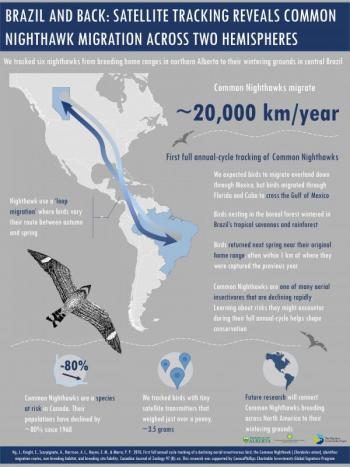To Brazil and Back: Nighthawk Migration Revealed
We haven’t seen one yet this fall, but a few people in Maine have noted the first pulses of southbound, migrating common nighthawks. Based on checklists submitted to eBird, Maine should expect peak numbers within the next two weeks. Common nighthawks were once relatively common breeders in many Maine cities and towns, nesting on the flat, tar and loose gravel-topped roofs that were the norm back then. Today, these birds have disappeared from most Maine cities and towns, but small numbers nest in scattered locations around the state (particularly eastern and northern areas), where they ley their two eggs on the ground in barren, gravelly areas. Across North America, common nighthawks have declined by more than 60 percent since the 1960s, with even steeper declines in Maine and across Canada.
For years, ornithologists have had a vague sense of common nighthawk migration routes and possible wintering areas, given that migrating birds were sometimes seen in the Caribbean and Central America, and that some common nighthawks had been collected and occasionally seen in the general Amazon basin region of South America. But such information provided only a general idea of where some birds may go some of the time. We didn’t know, for example, whether birds from certain parts of the nesting range migrated to particular regions to spend the winter.
All that is beginning to change thanks to the work of an ambitious research team focusing on migratory tracking of common nighthawks. Led by Janet Ng of the University of Alberta, the first results of the work were published just a few months ago. The team placed tiny units on ten birds from a nesting area in northern Alberta. The units contained a GPS unit that recorded the locations of the birds and periodically sent that information to a satellite where it could be downloaded by the researchers. Seven of the ten units worked (the researchers don’t know what happened to the other three), and five worked throughout the entire year, providing data on southbound migration, wintering areas, and northbound migration.
The southbound migration of these five common nighthawks started in the second week of August, with the birds heading across the U.S. and passing through Florida by September. They dropped down into Cuba and then across the wide expanse of the Caribbean Sea to Venezuela and Colombia, all making it safely to the South American continent by October. They dropped south and east from there, reaching their wintering area in east-central Brazil by November. Because of the pinpoint accuracy of the location data, the researchers were able to study the landscape where the birds spent the winter, showing that it was largely an agricultural landscape interspersed with small woodlots.
The birds began their northward journey in March, following a similar route across the Caribbean to Cuba and into Florida, not arriving in the U.S. until early May and not reaching their northern Alberta breeding grounds until June.
We’re looking forward to seeing more results from other populations of common nighthawks that are being studied by this team. Hopefully, we will find out more about why this species is declining and how we can ensure that they are always here for generations of bird lovers to observe, enjoy, and learn from into the future.
Jeffrey V. Wells, Ph.D., is a Fellow of the Cornell Lab of Ornithology. Dr. Wells is one of the nation's leading bird experts and conservation biologists and author of the “Birder’s Conservation Handbook.” His grandfather, the late John Chase, was a columnist for the Boothbay Register for many years. Allison Childs Wells, formerly of the Cornell Lab of Ornithology, is a senior director at the Natural Resources Council of Maine, a nonprofit membership organization working statewide to protect the nature of Maine. Both are widely published natural history writers and are the authors of the popular book, “Maine’s Favorite Birds” (Tilbury House) and the newly released “Birds of Aruba, Bonaire, and Curaçao” from Cornell University Press.





























